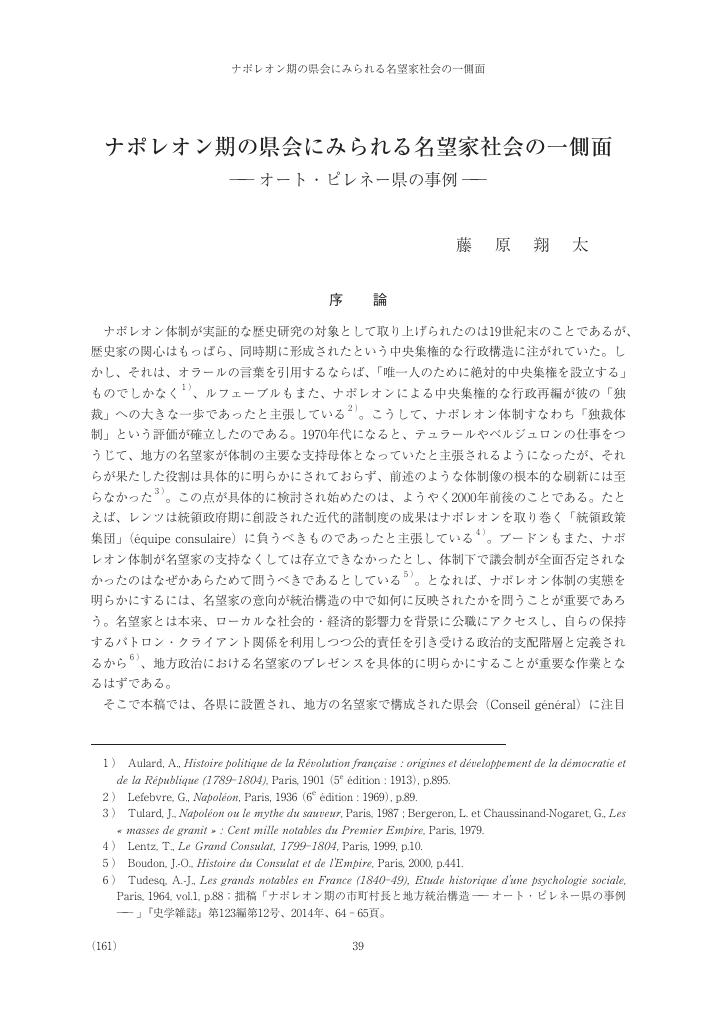1 0 0 0 OA ナポレオン期の県会にみられる名望家社会の一側面 オート・ピレネー県の事例
- 著者
- 藤原 翔太
- 出版者
- 日本西洋史学会
- 雑誌
- 西洋史学 (ISSN:03869253)
- 巻号頁・発行日
- vol.264, pp.39, 2017 (Released:2022-05-04)
- 著者
- 藤原 翔太
- 出版者
- 広島史学研究会
- 雑誌
- 史学研究 = Review of historical studies (ISSN:03869342)
- 巻号頁・発行日
- no.305, pp.181-202, 2020-03
- 著者
- 藤原 翔太
- 出版者
- 日本西洋史学会
- 雑誌
- 西洋史学 = The studies in Western history (ISSN:03869253)
- 巻号頁・発行日
- no.264, pp.161-180, 2017
- 著者
- 藤原 翔太
- 出版者
- 公益財団法人史学会
- 雑誌
- 史學雜誌 (ISSN:00182478)
- 巻号頁・発行日
- vol.123, no.12, pp.2149-2177, 2014-12-20
On 17 February 1800, the Consulat enacted a law concerning the districting and administration of the entire territory of France, and embarked on fundamental reforms that would lead to the encouragement and reinforcement of the centralization of local administrative institutions. However, the law also reintroduced the commune system, thus reviving local autonomy, a fact which has long been neglected. Once noticed, this fact leads to the question of why the regime of Napoleon, which has been considered to be a centralized one, needed to reorganize certain structural features of local autonomous institutions. In order to answer this question, the author of this article examines the structure of local governance under Napoleon by focusing on the town mayors who represented both the communes and central state authority in the prefectures of the Hautes-Pyrenees. The mayors of rural towns and cities who served under Napoleon have long been criticized for being "incompetent" and in league with their constituents, problems that were fully recognized by contemporary governors of prefectures and arrondissements (prefects and vice-prefects), as well as by the central government. Therefore, the prefectures proposed that any canton larger in area than a commune should have one paid mayor; however, the central government ignored this proposal and persisted in maintaining the commune system. This means that the government regarded the appointment of mayors based on the commune system as the best way to rule at the local level. Such a conclusion leads to the question of how the mayors, who were so important in terms of local rule, were actually chosen. To answer this question, the author first turns to an examination of the available mayoral prosopography and finds that there were definite differences in social status between the mayors of canton administrative centers (chef-lieu) and those of ordinary communes. Moreover, regarding the actual administration of local authorities, we find unique solutions adopted by prefecture-level bureaus to deal with problems caused by the mayors of rural towns and cities. Despite obvious regional differences, in the economic and cultural periphery of the Pyrenees, administrative affairs of the greatest import were carried on at the canton level. Rather than this fact indicating that the commune system was being treated as a mere formality, we find mayors of chef-lieu, who were selected from the ranks of local dignitaries, utilizing their political influence to guide politicians of inferior status and power in their duties as mayors of ordinary communes. In this sense, the commune system should be considered as having been introduced into a highly centralized, socially stratified political order for the purpose of integrating political power and influence at the regional level.
- 著者
- 藤原 翔太
- 出版者
- 公益財団法人 史学会
- 雑誌
- 史学雑誌 (ISSN:00182478)
- 巻号頁・発行日
- vol.123, no.12, pp.2149-2177, 2014
On 17 February 1800, the Consulat enacted a law concerning the districting and administration of the entire territory of France, and embarked on fundamental reforms that would lead to the encouragement and reinforcement of the centralization of local administrative institutions. However, the law also reintroduced the commune system, thus reviving local autonomy, a fact which has long been neglected. Once noticed, this fact leads to the question of why the regime of Napoleon, which has been considered to be a centralized one, needed to reorganize certain structural features of local autonomous institutions. In order to answer this question, the author of this article examines the structure of local governance under Napoleon by focusing on the town mayors who represented both the communes and central state authority in the prefectures of the Hautes-Pyrenees. The mayors of rural towns and cities who served under Napoleon have long been criticized for being "incompetent" and in league with their constituents, problems that were fully recognized by contemporary governors of prefectures and arrondissements (prefects and vice-prefects), as well as by the central government. Therefore, the prefectures proposed that any canton larger in area than a commune should have one paid mayor; however, the central government ignored this proposal and persisted in maintaining the commune system. This means that the government regarded the appointment of mayors based on the commune system as the best way to rule at the local level. Such a conclusion leads to the question of how the mayors, who were so important in terms of local rule, were actually chosen. To answer this question, the author first turns to an examination of the available mayoral prosopography and finds that there were definite differences in social status between the mayors of canton administrative centers (chef-lieu) and those of ordinary communes. Moreover, regarding the actual administration of local authorities, we find unique solutions adopted by prefecture-level bureaus to deal with problems caused by the mayors of rural towns and cities. Despite obvious regional differences, in the economic and cultural periphery of the Pyrenees, administrative affairs of the greatest import were carried on at the canton level. Rather than this fact indicating that the commune system was being treated as a mere formality, we find mayors of chef-lieu, who were selected from the ranks of local dignitaries, utilizing their political influence to guide politicians of inferior status and power in their duties as mayors of ordinary communes. In this sense, the commune system should be considered as having been introduced into a highly centralized, socially stratified political order for the purpose of integrating political power and influence at the regional level.
